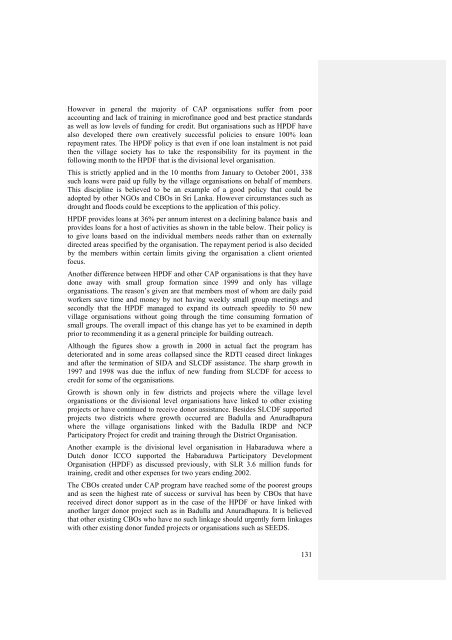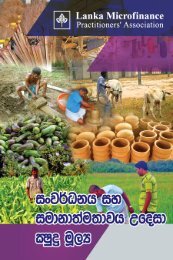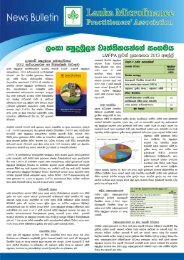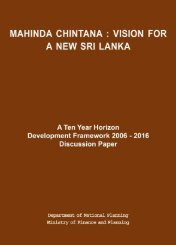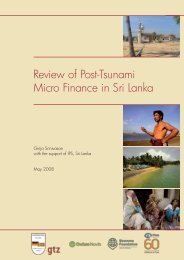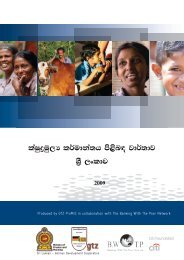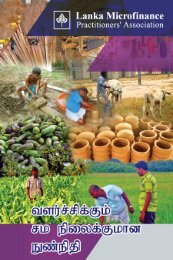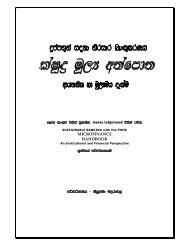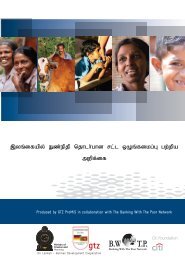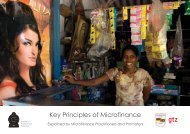National Microfinance Study of Sri Lanka: Survey of Practices and ...
National Microfinance Study of Sri Lanka: Survey of Practices and ...
National Microfinance Study of Sri Lanka: Survey of Practices and ...
Create successful ePaper yourself
Turn your PDF publications into a flip-book with our unique Google optimized e-Paper software.
However in general the majority <strong>of</strong> CAP organisations suffer from poor<br />
accounting <strong>and</strong> lack <strong>of</strong> training in micr<strong>of</strong>inance good <strong>and</strong> best practice st<strong>and</strong>ards<br />
as well as low levels <strong>of</strong> funding for credit. But organisations such as HPDF have<br />
also developed there own creatively successful policies to ensure 100% loan<br />
repayment rates. The HPDF policy is that even if one loan instalment is not paid<br />
then the village society has to take the responsibility for its payment in the<br />
following month to the HPDF that is the divisional level organisation.<br />
This is strictly applied <strong>and</strong> in the 10 months from January to October 2001, 338<br />
such loans were paid up fully by the village organisations on behalf <strong>of</strong> members.<br />
This discipline is believed to be an example <strong>of</strong> a good policy that could be<br />
adopted by other NGOs <strong>and</strong> CBOs in <strong>Sri</strong> <strong>Lanka</strong>. However circumstances such as<br />
drought <strong>and</strong> floods could be exceptions to the application <strong>of</strong> this policy.<br />
HPDF provides loans at 36% per annum interest on a declining balance basis <strong>and</strong><br />
provides loans for a host <strong>of</strong> activities as shown in the table below. Their policy is<br />
to give loans based on the individual members needs rather than on externally<br />
directed areas specified by the organisation. The repayment period is also decided<br />
by the members within certain limits giving the organisation a client oriented<br />
focus.<br />
Another difference between HPDF <strong>and</strong> other CAP organisations is that they have<br />
done away with small group formation since 1999 <strong>and</strong> only has village<br />
organisations. The reason’s given are that members most <strong>of</strong> whom are daily paid<br />
workers save time <strong>and</strong> money by not having weekly small group meetings <strong>and</strong><br />
secondly that the HPDF managed to exp<strong>and</strong> its outreach speedily to 50 new<br />
village organisations without going through the time consuming formation <strong>of</strong><br />
small groups. The overall impact <strong>of</strong> this change has yet to be examined in depth<br />
prior to recommending it as a general principle for building outreach.<br />
Although the figures show a growth in 2000 in actual fact the program has<br />
deteriorated <strong>and</strong> in some areas collapsed since the RDTI ceased direct linkages<br />
<strong>and</strong> after the termination <strong>of</strong> SIDA <strong>and</strong> SLCDF assistance. The sharp growth in<br />
1997 <strong>and</strong> 1998 was due the influx <strong>of</strong> new funding from SLCDF for access to<br />
credit for some <strong>of</strong> the organisations.<br />
Growth is shown only in few districts <strong>and</strong> projects where the village level<br />
organisations or the divisional level organisations have linked to other existing<br />
projects or have continued to receive donor assistance. Besides SLCDF supported<br />
projects two districts where growth occurred are Badulla <strong>and</strong> Anuradhapura<br />
where the village organisations linked with the Badulla IRDP <strong>and</strong> NCP<br />
Participatory Project for credit <strong>and</strong> training through the District Organisation.<br />
Another example is the divisional level organisation in Habaraduwa where a<br />
Dutch donor ICCO supported the Habaraduwa Participatory Development<br />
Organisation (HPDF) as discussed previously, with SLR 3.6 million funds for<br />
training, credit <strong>and</strong> other expenses for two years ending 2002.<br />
The CBOs created under CAP program have reached some <strong>of</strong> the poorest groups<br />
<strong>and</strong> as seen the highest rate <strong>of</strong> success or survival has been by CBOs that have<br />
received direct donor support as in the case <strong>of</strong> the HPDF or have linked with<br />
another larger donor project such as in Badulla <strong>and</strong> Anuradhapura. It is believed<br />
that other existing CBOs who have no such linkage should urgently form linkages<br />
with other existing donor funded projects or organisations such as SEEDS.<br />
131


